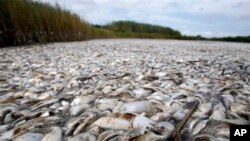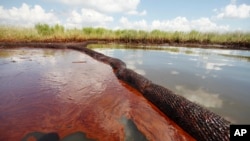From VOA Learning English this is As It Is!
I’m Anna Matteo in Washington.
Coming up we hear about a dead zone in waters near the United States. This dead zone has nothing to do with burial places, zombies or monsters or that 1983 movie called “The Dead Zone.”
Christopher Cruise tells us what a dead zone is and how some scientists are trying to bring it back to life.
The area known as a dead zone develops every spring in the Gulf of Mexico near the mouth of the Mississippi River. It can be as large as 13,600 square kilometers, extending all the way to the eastern Texas shoreline.
Scientists know what causes this dead zone, and a new study suggests an answer. But the solution might be hard to accept for those who live far away from the coastline.
Bayani Cardenas is a professor of water studies at the University of Texas at Austin.
He wondered why natural cleaning, or filtration, does not remove nitrates from the Mississippi River that create the dead zone in the Gulf of Mexico. He says rivers generally filter out materials like nitrates.
"You can think of it as a spiraling flow back around the bank of the river, where a water molecule goes into the bank, comes back out into the river at some downstream point, and it does that repeatedly as it travels downstream."
Professor Cardenas says his recent study shows that more than 99 percent of the river’s water does pass through the river bank material, or sediments, on its way south. But he adds that the river system is simply overwhelmed by the amount of nitrogen it carries.
This nitrogen-rich water supports the growth of algae. As the algae dies, it sinks to the bottom where it breaks down, or decomposes, taking oxygen from the water. This condition is called hypoxia and is deadly to fish and shrimp.
The Mississippi river system carries water to the gulf from 33 states and two Canadian provinces. Along the way, chemicals like nitrogen that are used in farming enter the river system. Farmers say the chemicals are necessary. But Mr. Cardenas thinks that the only way to fix the dead zone problem is for farmers to use less nitrates.
Aaron Packman is a civil and environmental engineering professor at Northwestern University. He says farmers may be able to better control the amount of nitrate fertilizer they put on fields.
“How much fertilizer do you need to give you good yields and then how much is maybe a marginal gain from adding lots more fertilizer? So there is really a question here: can you maybe back that off (reduce the amount) and maybe get close to the same level of yield without having such a negative impact.”
Aaron Packman explains how large the Mississippi river system is. He also describes how farming practices upstream affect the areas downstream.
“The Mississippi river system is 40 percent of the surface area of the continental United States. I think it takes some further work in the distributive areas upstream that are the source of a lot of the nutrient.”
The water in the Mississippi river system should be able to clean, or filter, itself naturally as it flows downstream. But human-made structures used to improve travel on the river and to control floods have hurt this natural cleaning process.
Bayani Cardenas says filtration works better when the river water travels through twists and turns. These twists and turns force the water to spend more time in the natural materials that clean it.
“A straight channel won’t offer this buffering. A very sinuous channel provides a lot of the contact of the river water with the sediment.”
In the coming months, storms will mix the gulf water and the dead zone will disappear. But it will return next year. And scientists say it will grow larger in years to come if something is not done to reduce the amount of nitrogen in the Mississippi River.
I'm Christopher Cruise.
Thanks, Christopher.
And I’m Anna Matteo in Washington.
Too much nitrogen leads to too much algae which leads to dead fish -- proving that too much of a good thing is sometimes not good.
When have you had too much of a good thing? Tell us in our comments section! It's a great place to practice your written English.








